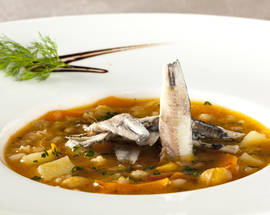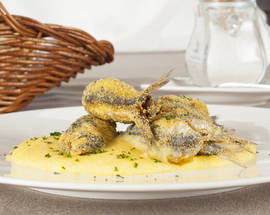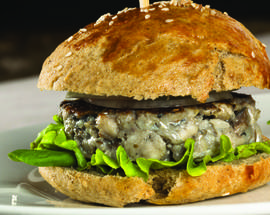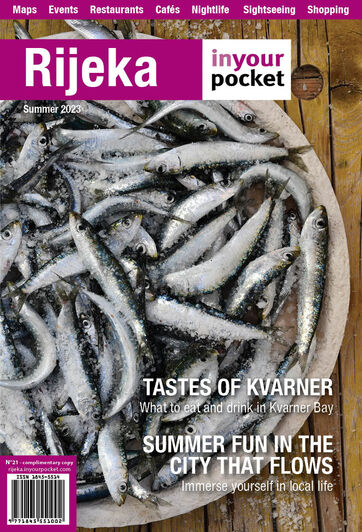Crikvenica and its ties to blue fish by Darko Baretić Barba
more than a year agoDarko Baretić Barba decided to change that and restore the dignity of blue fish, popularising it the way it deserves. And he is one person who can rightfully do so because not only is he a food blogger, a critic of fine gastronomy and wine, a hedonist and a man who knows every corner of per excellence taverns and restaurants of the Primorje and Kvarner region and beyond, but he is also a child of Crikvenica. He grew up in a time when fleets and the shipment of blue fish around Crikvenica, together with those from Kali, were the largest of all Adriatic ports on the Croatian side of the coast. His cookbook on bluefish, ‘The Blondes Without Bones’ is a great and worthy tribute to harvesting blue fish after which Crikvenica is widely known.
Apart from being a story of a man’s childhood and history, it is also a story about the present and the bright future ahead; just as Darko Baretić had returned with pictures and words to his roots, but in a little more modern way. In his cookbook, an anchovy is cut into fillets; burgers and moussaka are made of blue fish, only to show in which directions a recipe with blue fish can and should go. Nevertheless, one ought to start from the beginning, from asking why books exist at all. And then there is the PŠRD Association called ‘Arbun’ from Crikvenica who, to mark their 65 years of existence requested to write a cookbook instead of a biography depicting their history. And naturally, Baretić was the logical choice for the author. ‘When you get to a certain age, say 60, you’ve got to do something for the common good. You need to give something back to your homeland, society, and community’, says Baretić.
He wanted, like he said, to repay and pay respects to the people of his hometown, recall his childhood when children from the Crikvenica promenade would jump into the sea filled with blue fish in full fishing nets. Crikvenica ‘kids’ jumped in the 1950s on seiner and trawlers, on those 18 anchored ships that were tied to the port. The catch of small blue fish was a main source of income, just as blue fish were the main ingredient for Crikvenica inhabitants who cooked in many and various imaginative ways. Primorje inhabitants who lived along the sea have been raised on blue fish, explains Barba.
And while the book alternates recipes and memories, the master educates, teaching us how blue fish is healthy and can be prepared in a million ways. Marinade per kirski, moussaka from blue fish, minestrone soup with boiled anchovies, Barba's stew with noodles.... He explains why it is blue fish of all fish? Despite the tradition and love for fishing in Crikvenica. ‘Well, firstly, blue fish is cheaper than white fish, and during a recession that is important. It is nutritionally valuable, and historically it has fed so many people in these parts thanks to the sheer numbers of the fish and at almost free to nothing. In terms of gastronomy, a trend in choosing white fish has prevailed, yet in this day and age restaurants cannot live off customers who will buy only grouper and snapper alone’, says Baretić.
Blue fish is not only to be thrown on the ‘grill’, but one can use over three hundred miracles with it. Therefore Baretić praises the organisation PŠRD ‘Arbun’ and its members who every so often organise activities for tourists where they are taught the techniques of processing pelagic fish, as well as filleting and salting. And we mustn’t forget the proof that a big come back ‘of boneless blondes’ is already happening, as testified by the menus of known and recognised restaurants where blue fish is slowly but surely returning to the price list.
Darko Baretić admits that this cookbook pays homage to fisheries and the fisherman who have for one hundred years, from the late 19th and early 20th century, assisted in the development of Crikvenica. He admits that the flavours and scents from childhood cannot fully return, but fortunately there are things which cannot be harmed by the past. ‘There are three timeless determinants of a high quality cuisine; top quality ingredients, a love towards work and the people one cooks for, and naturally a superior knowledge of cooking techniques’, Barba relates.
Sardines, anchovies, and small mackerel including golci are there. And that is just the beginning as other varieties can easily be found between the covers of Barba’s book. Therefore, bon appetite!
Crikvenica od plave ribe iz pera Darka Baretića Barbe
Nanese li vas, recimo petkom, put do naših ribarnica, najveće redove jamačno će te zapaziti pred štandovima na kojim je friške srdele i inćuna. Plava riba je ona koja se najviše kupuje i zato jer je jeftinija, i zato što je iznimno zdrava. Ali, dok se mjerka srdela svjedano se na glas snuje ona oborita, bijela riba, kakav zubatac ili škarpina. Reklo bi se, od plave ribe se živi, dok se sanja bijela riba i to veliki bokuni.
Najblaže rečeno nefer je to odnos prema ribi koja je cijelu našu obalu othranila i odgojila. Darko Bartić Barba odlučio je to promijeniti, vratiti plavoj ribi dignitet, popularizirati je kako je i zaslužila. On je taj koji to s pravom i može, jer ne samo da je food bloger, gastro i eno kritičar, hedonist i čovjek koji zna svaki kutak valjanih, dobrih konoba, oštarija i restorana Primorja i Kvarnera, a i šire, već je i dijete Crikvenice i to iz doba kada su flota i količine prekrcaja plave ribe, koje su Crikveničani imali, uz one Kaljana, bile najveće od svih jadranskih luka, na hrvatskoj strani obale. Njegova ribarska kuharica plave ribe "Plavuše bez kostiju" velika je i vrijedna posveta izlovu plave ribe po kojom je Crikvenica bila nadaleko znana.
No, osim što je to priča o djetinjstvu i povijesti, priča je to i o sadašnjosti i svijetloj nam budućnosti. Jer, Darko Baretić vratio se slikom i riječju korjenima, ali na malo moderniji način. U njega se srdela filetira, od plave ribe rade burgeri, musaka, tek da se vidi u kom pravcu priča s plavom ribom može i treba ići. No, valja ipak krenuti od početaka, od "krivca" što knjige uopće ima, a krivac je PŠRD "Arbun" iz Crikvenice u kojem su svojih 65 godina postojanja odlučili obilježiti na pomalo nespecifičana način. Umjesto klasične monografije, poželjeli su kuhariu! A kad je tako, Baretić ja bio logičan izbor za autora.
– Kad uhvatiš neke godine, recimo 60, moraš radit nešto za opće dobro. Treba nešto vratiti rodnom kraju, društvu, zajednici - kazuje nam Baretić.
Htio se, kako veli, odužiti ljudima svoga mjesta, prisjetiti djetinjstva kad su momčići s crikveničke rive skakali u more što se bijeli mnoštva plave ribe u prepunim ribarskim mrežama. Crikvenička "mularija" skakala je tih pedestih godina po tunolovcima i kočaricama, po onih 18 brodova-plivaričara vezanim u portu. Izlov sitne plave ribe bio je glavni izvor prihoda, baš kao što je plava riba bila osnovna namirnica prehrene koji su Crikveničani spravljalo na vrlo maštovite načine. Primorci uz more su odrasli na plavoj ribi, pojašnjava Barba.
A dok se u knjizi smjenjuju recepti i sjećanja, majstor nas educira, uči koliko je plava riba zdrava i na koliko se mali milijun načina može spraviti. Marinada po kirski, musaka od plave ribe, maneštra s lešo inćunima, Barbin brudet sa širokim rezancima.... A zašto plava riba, osim tradicije i ljubavi za ribarstvom u Crikveničana.
- Kao prvo, plava riba je jeftinija od bijele, a to u ovo recijsko vrijeme nije nevažno. Nutricionistički je vrijedna, a i odgojila je ona ljude ovoga kraja jer je bila jeftinija i masovna. U gastronomiji je prevladao trend oborite bijele ribe, no danas se ne može živjeti od kupaca koji će kupovati samo škarpine i zubace - uči Baretić.
Nije plava riba samo za bacit' je na gradele, već se s njom tristi čuda da učiniti. Zato će Baretić i pohvaliti članstvo PŠRD "Arbun" koji svako toliko za turiste organiziraju akcije za kojih ih uče tehnikama obrade plave ribe, filetiranju, soljenju. A da se veliki come back "plavuša bez kostiju" već događa, svjedoče i jelovnici poznatih i priznatih restorana na koje se plava riba polako, ali sigurno, vraća.
Priznaje Darko Baretić kako je ova kuharica hommage ribarstvu i zanimanju ribar koji su obilježili stotinjak godina, kraj 19. i početak 20. stoljeća, u razvoju Crikvenice. Priznaje i da se okusi i mirisi djetinjstva ne mogu u potpunosti vratiti, ali ima na sreću stvari kojima protok godina ne može ništa.
- Tri su svevremenske odrednice svake vrhunske gastronomije; vrhunska namirnica, ljubav prema poslu i osobama kojima kuhaš, i vrhunsko poznavanje kuharskih tehnika - uči Barba.
Srdele, inčuni, male lokarde iliti golci, su tu. Ostalo se lako može naći i među koricama Barbine knjige. Stoga, u slast vam bilo.
By Siniša Pavić








Comments